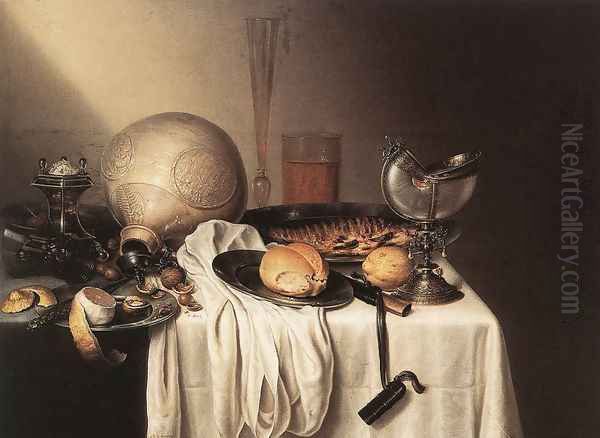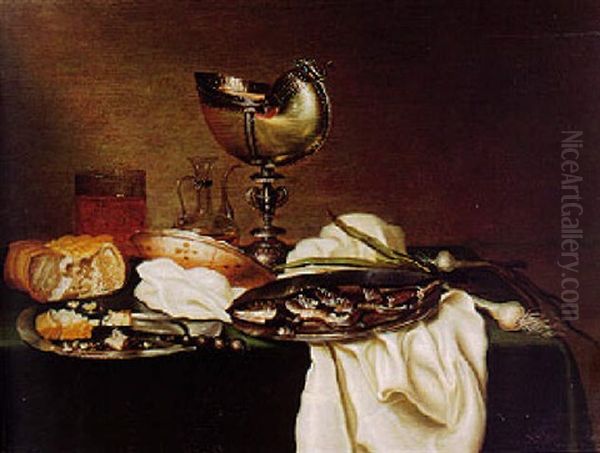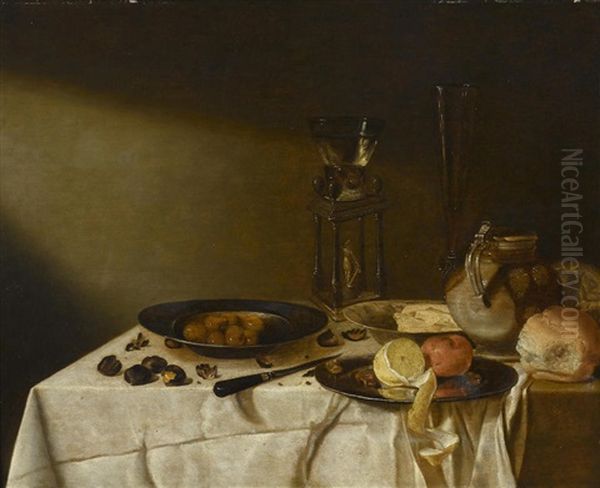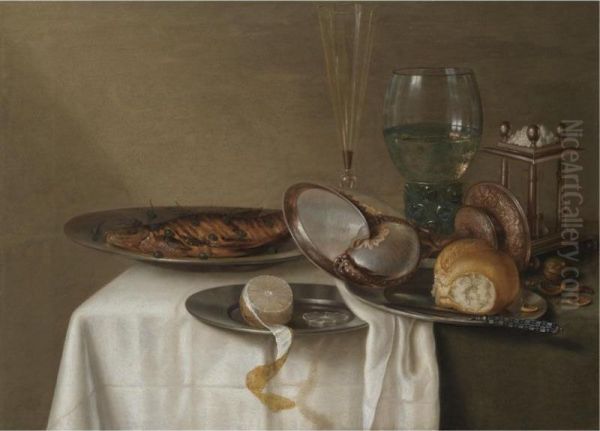The Dutch Golden Age, spanning roughly the 17th century, was a period of extraordinary artistic efflorescence. Amidst the clamor of celebrated masters like Rembrandt van Rijn and Johannes Vermeer, numerous other talented individuals contributed to the rich tapestry of Dutch art. Among them was Maarten Boelema de Stomme, a painter whose life and work offer a unique window into the world of Haarlem still life, made all the more remarkable by his personal circumstances. Though his career was tragically short, his surviving paintings demonstrate a keen eye for detail and a mastery of the genre.
Early Life and the Weight of an Epithet
Maarten Boelema was born in Leeuwarden, the capital of the province of Friesland, in 1611. Little is definitively known about his early childhood or familial background, though some sources suggest his father may have been a lawyer. What is certain, and what came to define his public persona, was that he was deaf-mute. This condition led to his widely used epithet, "de Stomme," meaning "the Mute" or "the Silent One." In an era when verbal communication was paramount, and when artistic theory often emphasized the intellectual and articulate nature of the painter, being deaf-mute presented significant challenges.
Despite these hurdles, Boelema's artistic talent must have been evident from a young age. The path for a deaf-mute individual to enter a highly skilled profession like painting was not straightforward. It speaks volumes about his determination, and perhaps the support of his family or early mentors, that he pursued this vocation. His condition likely shaped his perception of the world, perhaps heightening his visual acuity and sensitivity to the nuances of light, texture, and form – qualities essential for a still life painter.
The epithet "de Stomme" was not unique to Boelema in Dutch art history. The renowned winter landscape painter Hendrick Avercamp (1585-1634) was similarly known as "de Stomme van Kampen" (the Mute of Kampen). This suggests a societal practice of identifying artists with significant physical characteristics, though it also underscores the relative rarity of individuals with such conditions achieving professional artistic status.
Apprenticeship in Haarlem: Under the Wing of Willem Claesz. Heda

To hone his skills, Maarten Boelema de Stomme journeyed to Haarlem, a bustling center of artistic innovation, particularly renowned for its still life painters. It was here, around 1642, that he became a pupil of one of the genre's leading figures, Willem Claesz. Heda (1594-1680). Heda, along with Pieter Claesz. (1597/98-1660), was a pioneer of the "monochrome banketje" or "ontbijtje" (breakfast piece) – still lifes characterized by a subtle, near-monochromatic palette, exquisite rendering of textures, and carefully arranged compositions of everyday objects.
Training under Heda would have immersed Boelema in the sophisticated techniques and aesthetic principles of the Haarlem school. He would have learned to meticulously observe and depict the play of light on various surfaces: the gleam of a silver tazza, the transparency of a glass roemer, the soft crumb of bread, and the rich sheen of a ham. Heda's studio was a crucible of talent, and Boelema would have worked alongside other aspiring artists, including Heda's own son, Gerret Willemsz. Heda (c. 1620/25-c. 1649), who also became a notable still life painter in his father's style.
In 1642, a significant year for Boelema, he was officially enrolled as a member of the Haarlem Guild of St. Luke. Membership in the guild was essential for any artist wishing to practice professionally, sell their work, or take on pupils. This indicates that he had achieved a recognized level of competence and was accepted by his peers, a notable accomplishment given his deafness.
The Haarlem School of Still Life: A Context for Boelema's Art
The Haarlem school of still life painting, in which Boelema was steeped, represented a distinct development within Dutch art. Earlier still lifes, such as those by Floris van Dyck (1575-1651) or Nicolaes Gillis (c. 1580-after 1632), often featured brighter colors and a more additive approach to composition, with objects spread out across the canvas. Heda and Pieter Claesz. revolutionized this by adopting a more unified, atmospheric approach.
Their "monochrome" palettes, typically dominated by browns, grays, and greens, allowed for a greater focus on tonal values and the subtle interplay of light and shadow. This created a sense of harmony and restraint, even when depicting luxurious items. Compositions became more dynamic, often employing diagonals and carefully balanced arrangements of objects that seemed to exist in a tangible, shared space. These paintings were not merely displays of technical skill; they often carried symbolic meanings, alluding to themes of temperance, the transience of life (vanitas), or the prosperity of the Dutch Republic.

The objects depicted were frequently drawn from the everyday life of the affluent Dutch burgher: pewter plates, simple glassware, bread, cheese, nuts, and local fruits. However, more luxurious items like silver tazze (footed dishes), nautilus cups, Chinese porcelain, and imported lemons also appeared, reflecting the Netherlands' burgeoning global trade and wealth. Boelema's work fits squarely within this tradition, demonstrating his absorption of its key characteristics.
Boelema's Artistic Style and Signature Motifs
Maarten Boelema de Stomme's artistic output, though limited by his short career, showcases a distinct style that aligns closely with that of his master, Heda, yet possesses its own subtle inflections. He worked primarily in oil on panel, a common practice for still life painters of the period. His compositions are generally less cluttered than some of Heda's more elaborate banquet pieces, often focusing on a smaller selection of objects arranged with an elegant simplicity.
A hallmark of Boelema's style is his meticulous attention to detail and his ability to render textures with remarkable verisimilitude. The cool, reflective surface of metal, the delicate transparency of glass, the rough rind of a lemon, and the moistness of a sliced ham are all captured with a patient, observant brush. His lighting is often subtle, creating soft shadows and gentle highlights that unify the composition and imbue it with a quiet, contemplative mood.
Common motifs in his paintings include pewter plates, roemers (greenish wine glasses with studded bases), overturned silver tazze, knives with ornate handles, peeled lemons (their vibrant yellow a striking accent in the otherwise subdued palette), nuts, and, notably, hams. The depiction of ham, often sliced to reveal its rich pink interior, was a specialty of many Haarlem painters, including Heda and Pieter Claesz., and Boelema excelled in its portrayal. The nautilus shell, often mounted in elaborate silver or gilt settings to form a drinking cup, also appears in his work, signifying luxury and the exotic allure of overseas trade.
Analysis of Key Works: A Glimpse into Boelema's World
Despite his brief period of activity, primarily documented between 1642 and his death in 1644, several key works allow us to appreciate Boelema's skill.

One of his most celebrated paintings is the Still Life with Ham, Lemon, and Overturned Tazza, dated 1641 and now housed in the Suermondt-Ludwig Museum in Aachen. This work exemplifies the Haarlem "ontbijtje." A partially sliced ham dominates the composition, its rich texture and color meticulously rendered. Beside it, a peeled lemon, its skin spiraling downwards, adds a touch of brightness and a potential vanitas symbol (the bitterness of life underlying outward beauty). An overturned silver tazza, a common motif in Heda's work, suggests a recently concluded meal or the fleeting nature of earthly pleasures. A bread roll, a knife, and a roemer complete the arrangement, all bathed in a soft, diffused light that highlights their forms and textures. The composition is balanced and harmonious, demonstrating Boelema's command of the genre's conventions.
Another significant piece is the Still Life with Nautilus Cup, also often dated to 1641 (though some sources suggest 1640 or 1642), located in the Hallwyl Museum in Stockholm. Here, the magnificent nautilus cup, an exotic and costly object, takes center stage. Its pearlescent sheen and intricate silver-gilt mount are rendered with exquisite care. Accompanying it are familiar elements: a roemer, a pewter plate with a bread roll, and perhaps a hint of a ham or other foodstuffs. The inclusion of such a prized object elevates the status of the still life, showcasing both the painter's skill and the patron's affluence.
A Breakfast Still Life from 1644, reportedly in a private collection, further illustrates his mature style. It features a simple yet elegant arrangement of ham, bread, and wine. Even in such seemingly straightforward compositions, Boelema's ability to capture the essence of the objects and create a palpable sense of presence is evident. The Rijksmuseum in Amsterdam is also noted to hold a work titled Still Life by Boelema, though specific details of this piece are less widely circulated than the Aachen and Stockholm paintings. These works, though few, solidify his reputation as a skilled practitioner of the Haarlem still life.
Contemporaries and Artistic Dialogue: A Network of Influence
Boelema's artistic development was undeniably shaped by his direct interaction with Willem Claesz. Heda and, by extension, the broader circle of Haarlem still life painters. The similarities in subject matter, composition, and palette between Boelema's work and that of Heda, Pieter Claesz., and Gerret Willemsz. Heda are striking. They shared a common visual vocabulary, frequently depicting similar arrangements of tazze, roemers, hams, and lemons. This shared repertoire suggests a lively artistic dialogue, whether through direct collaboration, shared studio props, or mutual observation of each other's successful compositions.

Beyond this immediate circle, the Dutch art world was interconnected. While Boelema's focus was clearly on the Haarlem monochrome style, he would have been aware of other trends. For instance, in Amsterdam, painters like Jan Jansz. den Uyl (c. 1595/96-1639/40) also worked in a restrained, monochrome palette, while Willem Kalf (1619-1693) was developing his opulent "pronkstilleven" (ostentatious still lifes) characterized by richer colors and more lavish displays of luxury goods. In Utrecht, artists like Ambrosius Bosschaert the Elder (1573-1621) had earlier specialized in vibrant flower paintings, a genre that continued to flourish. Later, Jan Davidsz. de Heem (1606-1683/84), active in both Leiden and Antwerp, would become famous for his elaborate and richly colored still lifes.
Boelema's unique position as a deaf-mute artist also invites comparison with other artists who faced similar challenges. As mentioned, Hendrick Avercamp, "de Stomme van Kampen," achieved great fame for his lively winter scenes. Later in the 17th century, Johannes Thopas (c. 1626-c. 1690/95), also deaf-mute, was a highly skilled draftsman known for his detailed portraits in silverpoint and graphite. The success of these artists, including Boelema, demonstrates that physical limitations did not necessarily preclude artistic achievement in the Dutch Golden Age, though they undoubtedly presented unique obstacles.
The Enigma of a Short Career and Unanswered Questions
Maarten Boelema de Stomme's documented artistic career is remarkably brief, essentially spanning from 1642 until his death in Haarlem in 1644, at the young age of about 33. This tragically short lifespan means his oeuvre is small, and it leaves art historians to speculate on how his style might have evolved had he lived longer. Would he have continued in the monochrome tradition, or might he have embraced the richer palettes and more opulent compositions that became fashionable later in the century?
His deafness also raises questions about his artistic practice and interactions. How did he communicate with his master, Heda, or with patrons? Did his reliance on visual information lead to a heightened sensitivity in his paintings? While his works speak for themselves in terms of skill, the human story behind their creation remains partly shrouded.
There are also minor mysteries and debates surrounding his life. The precise details of his family background, for example, remain somewhat obscure. Some sources mention his father being a lawyer, but concrete evidence is scarce. The conservation history of his paintings also presents challenges; like many Old Master works, some may have undergone restorations or overpainting that could obscure original details or alter their appearance, making definitive attributions or analyses complex. For instance, discussions around the visibility of certain elements, like pipe stems in relation to silver cups, highlight the meticulous scrutiny required in studying these works.
Symbolism and Meaning: Reading Between the Brushstrokes
Dutch still life paintings of the 17th century were rarely mere depictions of objects. They were often imbued with layers of meaning, accessible to contemporary viewers familiar with a rich vocabulary of symbols. While Boelema's intentions are not explicitly documented, his works can be interpreted within this symbolic framework.
The "ontbijtjes" or breakfast pieces, with their depictions of simple fare like bread, cheese, and beer or wine, could celebrate the modest, everyday blessings of Dutch life. However, they could also carry connotations of temperance and moderation, virtues highly valued in Calvinist society.
More luxurious items, like the silver tazze, nautilus cups, and imported lemons, spoke of the Republic's wealth and global reach. Yet, these very symbols of worldly success could also serve as reminders of the transience of earthly possessions and pleasures – a central theme of "vanitas" still lifes. An overturned glass, a snuffed candle (though not prominent in Boelema's known work), or a watch could explicitly signal the passage of time and the inevitability of death. Even a peeled lemon, with its attractive exterior and sour taste, could symbolize the deceptive nature of appearances or the bittersweetness of life.
The careful arrangement of objects, the interplay of light and shadow, and the palpable sense of stillness in Boelema's paintings invite contemplation, encouraging the viewer to look beyond the surface and consider deeper meanings. His works, therefore, participate in the broader intellectual and moral discourse of his time.
Legacy and Rediscovery: A Quiet Voice Heard Anew
For centuries, Maarten Boelema de Stomme remained a relatively obscure figure, overshadowed by the giants of the Haarlem school like Heda and Claesz. His small oeuvre and short career contributed to this relative anonymity. However, in more recent times, art historians have paid closer attention to the contributions of "minor masters" and artists with unique life stories.
Boelema's work is now recognized for its quiet elegance, technical proficiency, and its embodiment of the key characteristics of Haarlem still life. His paintings are valued not only for their aesthetic qualities but also for what they reveal about the artistic practices of the period and the life of an artist who overcame significant personal challenges. His status as a deaf-mute artist has also drawn interest from scholars studying disability in art history, highlighting his achievement in a world that was not always accommodating.
His works are now found in respected museum collections, ensuring their preservation and accessibility for study and appreciation. Exhibitions focusing on Dutch Golden Age still life or the art of Haarlem often include his paintings, allowing contemporary audiences to encounter his subtle artistry. For example, his work has been contextualized alongside contemporaries like Jan Jansz. de Wassenbergh and Herman Collenius in exhibitions exploring regional Dutch art, such as one held at the Groninger Museum.
Existing Works and Their Esteemed Homes
The most prominent and frequently discussed works by Maarten Boelema de Stomme reside in European museums. As previously mentioned:
The Suermondt-Ludwig Museum in Aachen, Germany, holds his iconic Still Life with Ham, Lemon, and Overturned Tazza (1641).
The Hallwyl Museum in Stockholm, Sweden, is home to the exquisite Still Life with Nautilus Cup (c. 1641/1642).
The Rijksmuseum in Amsterdam, Netherlands, also lists a Still Life by Boelema in its collection.
Other works are believed to be in private collections, and occasionally, pieces attributed to him or his circle appear on the art market. The limited number of securely attributed works makes each one particularly valuable for understanding his artistic contribution.
Conclusion: The Enduring Resonance of a Silent Master
Maarten Boelema de Stomme's life was short, and his voice was silent, but his art speaks with a quiet eloquence that continues to resonate. As a pupil of Willem Claesz. Heda, he mastered the subtle art of the Haarlem monochrome still life, creating compositions of refined beauty and technical skill. His ability to overcome the challenges of deafness to achieve professional recognition in the competitive art world of the Dutch Golden Age is a testament to his talent and determination.
Though his oeuvre may be small, his paintings offer a precious glimpse into the world of 17th-century Dutch still life, capturing the textures, forms, and symbolic resonances of everyday objects with a delicate and observant touch. Maarten Boelema de Stomme may have been "the Mute," but his brushstrokes have left an indelible and articulate mark on the history of art, reminding us that profound expression can emerge from the deepest silence. His work enriches our understanding of the Haarlem school and the diverse talents that flourished during one of art history's most luminous periods.